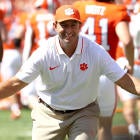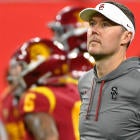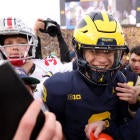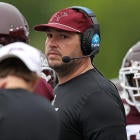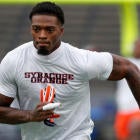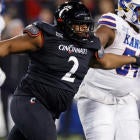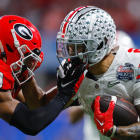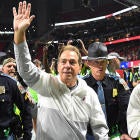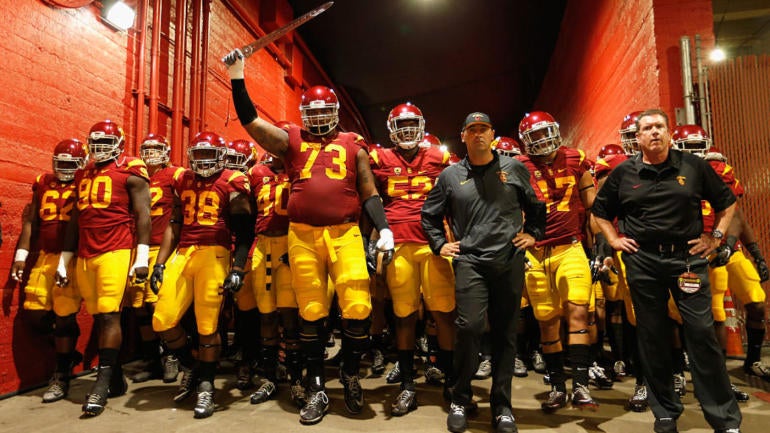
The Big Ten is going bi-coastal in 2024 as Oregon, UCLA, USC and Washington join the league following the Pac-12's demise. Expansion comes after the conference produced its first national champion (Michigan) since the 2014 season, and the four new arrivals will only add difficulty to what's already a brutal conference.
Along with the addition of the West Coast bloc, the Big Ten is eradicating divisions and granting league championship game access to the top two teams in the standings. While all four newbies boast strong football histories, their paths to the top of what is now an 18-team super conference will be treacherous.
Oregon is regarded as a plug-and-play league title contender, but there is plenty of intrigue surrounding the other three teams entering the 2024 season as well. UCLA and Washington are both led by first-year coaches, while USC is beginning a new era at defensive coordinator and quarterback following a disappointing season of regression.
The range of outcomes is vast for the Big Ten newcomers as they will crisscross the country playing unfamiliar foes up to three time zones away. As the season approaches, here's a look at the best- and worst-case scenarios for the league's splashy additions.
Oregon
Best case: National champions. With head coach Dan Lanning entering Year 3 and the return of quality coordinators Will Stein and Tosh Lupoi, the Ducks have the foundation to build off a 12-2 season that ended with a dominant Fiesta Bowl victory. Bo Nix is gone, but former UCF and Oklahoma star Dillon Gabriel is a perfect fit at quarterback. His receiver room is stacked, which should keep the Ducks from missing a beat after ranking No. 2 nationally in total offense last season. Even if Oregon falters at home against Ohio State or at Michigan, the schedule is friendly enough to keep it in contention for a playoff bid. From there, everything is dependent on matchups and health. A national title is squarely within reach for a team that ranked No. 3 in Dennis Dodd's post-spring top 25.
Worse case: 9-3, but missing the CFP. It's difficult to imagine a scenario in which Oregon loses more than three games during the regular season. However, if those three losses came against Ohio State, at Michigan and at Wisconsin, the Ducks would be left without much of a case for CFP inclusion. In that scenario, the Ducks' resume would be void of anything resembling a marquee victory, and their CFP candidacy would be murky at best. There will be 9-3 teams from the Big Ten and SEC that make the playoff in the 12-team era, but without a true marquee nonconference game -- a home contest against Boise State doesn't quite qualify -- Oregon may need to finish 10-2 or better to get in this year. While 9-3 is hardly a disaster for a program that is transitioning into the Big Ten, finishing without a big victory is a realistic worst-case scenario.
UCLA
Best case: Merely reaching a bowl game would mark a huge win for new head coach DeShaun Foster as he navigates the challenge of a brutal schedule as a first-time head coach. Moving to the Big Ten is tough enough, but that's just the beginning for the Bruins, who begin their season on the road against Hawaii. In addition to flying over the Pacific to play the Rainbow Warriors, UCLA also travels to LSU and hosts Fresno State in nonconference play. There isn't a single layup on this slate. If Foster can coax six victories out of this squad, it would be an encouraging start to his tenure and lay a solid foundation for UCLA's life in the Big Ten.
Worse case: UCLA started the Chip Kelly era with a 3-9 mark in 2018, and it's easy to see the 2024 Bruins posting a similar record. The roster is not deep or talented enough to handle the nation's top teams. A three-week stretch at LSU, vs. Oregon and at Penn State is one of the toughest runs faced by any team in the country in 2024. It will be imperative for UCLA to stay healthy and confident enough coming out of that stretch to beat Minnesota and Rutgers in mid-October. If the Bruins fall in those games, they could be in for a long November. The absolute worst-case scenario could see the Bruins sitting at 2-8 entering home tilts against USC and Fresno State to close the season and are shredded by those high-flying offenses in front of sparse crowds.
USC
Best case: If USC beats two of the following four teams: LSU, Michigan, Penn State, Notre Dame, then it's plausible that it could steal one of the final spots in the 12-team CFP. The Trojans have a great opportunity to make an early statement as they open against LSU in Las Vegas before playing at Michigan in their third game. Wins in those two contests would vault the Trojans squarely into the CFP picture and Big Ten title conversation. However, that won't happen without marked defensive improvement as D'Anton Lynn steps in as coordinator following Alex Grinch's dismissal.
Worse case: As with UCLA, there are no guaranteed wins on this schedule, and that introduces the doomsday scenario of USC failing to make a bowl. With star quarterback Caleb Williams gone, the Trojans may struggle to find an offensive identity at a time when their defense is in flux. While Lincoln Riley is one of the nation's foremost quarterback gurus, there will inevitably be some drop-off after replacing a generational talent under center. Miller Moss shined at quarterback in the Holiday Bowl, but playing LSU and Michigan away from home in two of the first three games marks a tough introduction to his stint as the full-time starter. An 0-2 mark in those contests would put USC's CFP hopes on life support before the end of September and ratchet up the heat on Riley. A USC team with wounded confidence navigating seven consecutive games -- including four road contests -- against Big Ten opposition could lead to a death spiral.
Washington
Best case: With so many new faces on the roster, a 9-3 finish amid the transition to coach Jedd Fisch and the Big Ten would be cause for celebration. The nonconference schedule is light and should help Fisch get off to a 3-0 start. The opening to league play is also soft (vs. Northwestern, at Rutgers). It's possible the Huskies could be 5-0 entering an Oct. 5 national title rematch with Michigan. Considering that game is at home and that the Wolverines are also undergoing massive changes, it's at least conceivable that Washington could exact revenge and start 6-0. However, the back half of the schedule features road games against Iowa, Penn State and Oregon.
Worse case: Missing a bowl game is possible. A full-on scrape-and-rebuild paired with the Big Ten transition could spell trouble. While Northwestern and Rutgers may look like a soft opening to league play, both programs are capable of beating a Huskies team that will be getting its bearings throughout September. In theory, the acquisition of Mississippi State transfer quarterback Will Rogers should give the offense a high floor. But he'll be playing behind an unproven offensive line that is sorely lacking in high-end talent and depth. The Huskies may be running on fumes and relying on freshmen in key spots by the time November arrives.












